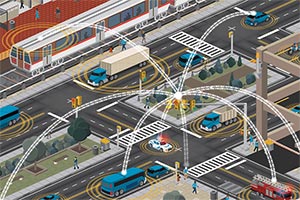FHWA Issues Guidance to States for V2I Use

This story appears in the Jan. 30 print edition of Transport Topics.
The Federal Highway Administration issued guidance to state and local governments for the adoption of vehicle-to-infrastructure programs, or V2I.
The Jan. 19 announcement said: “The guidance complements the department’s efforts to reduce crashes by advancing V2V [vehicle-to-vehicle] communication technology announced in a proposed rule in December,” from the National Highway Traffic Safety Administration.
“This is an important step in deploying a connected vehicle environment,” said Anthony Foxx, now former secretary of the U.S. Department of Transportation. FHWA and NHTSA are both DOT agencies.
“In addition to improving safety, vehicle-to-infrastructure technology offers tremendous mobility and environmental benefits,” said Gregory Nadeau, administrator of FHWA at the time.
“We took a big leap forward today by starting a national conversation about these topics, the future of V2I technologies and some of the bigger challenges facing us, such as privacy, security and interoperability,” Nadeau added.
Transportation department officials see V2I working among modes, listing four agencies taking part in its development in addition to FHWA: Federal Railroad Administration, Federal Transit Administration, Federal Motor Carrier Safety Administration and National Highway Traffic Safety Administration.
An FHWA fact sheet published with the announcement said, “The deployment of V2I technologies is not mandated and is not coupled with” the NHTSA proposal. NHTSA’s proposed V2V rule calls for the systems to become mandatory on cars and light trucks.
The FHWA fact sheet continued, “It is important for state and local agencies to understand what a decision to deploy V2I technology could mean to their region and how to prepare for the implementation of V2I technology. The V2I deployment guidance provides information for state and local agencies on a broad range of topics as they consider V2I technologies.”
State DOTs tend to like the technology, said Lloyd Brown, a spokesman for the American Association of State Highway and Transportation Officials.
“AASHTO has been a strong supporter of V2I, and our states have helped lead policies and research. AASHTO has also stood along with industry ... in defense of the frequency that V2I will need to function properly. That’s a strong consensus of support from AASHTO members on the topic generally,” Brown said.
An FHWA spokeswoman declined to answer follow-up questions because of the change in the presidency.
“President Trump signed a memo on Jan. 20 directing agencies like [DOT] and its many agencies to abide by a temporary freeze on pending regulations, rulemakings and guidance to give members of the new administration time to review them. To that end, we can’t easily answer your questions yet but hope to get back to you in the weeks ahead,” FHWA’s Nancy Singer said.
Michael Cammisa, vice president of safety policy and connectivity for American Trucking Associations, waded through some of the differences between the approaches to V2I and V2V by the U.S. Department of Transportation.
“With V2I, we’re mainly seeing technical requirements. State DOTs are the main audience but also local governments with authority over infrastructure,” he said. In contrast, NHTSA’s V2V proposal will make it mandatory for carmakers to install the systems sometime in the 2020s.
Cammisa said he is also waiting to see what the Trump administration will do but described connected vehicles as a “candidate to continue.”
“If infrastructure is equipped with V2I, it should be a good thing for all highway users,” he said.
While federal DOT agencies are an important part of the equation, the Federal Communications Commission will also play a role. Vehicles and infrastructure get connected through dedicated, short-range communications, which uses the 5.9 gigahertz segment of the electromagnetic spectrum — something controlled by the FCC.
The Wi-Fi industry has expressed interest in taking a portion of this spectrum — which has been reserved for transportation since 1999 — to service its growing customer base.
Ajit Pai is the new commission chairman. A Republican lawyer, Pai, 44, joined the FCC as a commissioner in May 2012 and was elevated to chairman on Jan. 23, after the Jan. 20 resignation of Tom Wheeler, a Democrat and the previous chairman.
Pai said on his FCC webpage that broadband is one of his selected issues.
He said the federal government “must streamline the process for deploying wireless infrastructure, from big towers to small cells. It must free up more licensed spectrum for use by wireless carriers and more unlicensed spectrum for things like Wi-Fi, and it must preserve internet freedom here and abroad, so that the online world can flourish free from heavy-handed government intervention.”
At the recent annual meeting of the Transportation Research Board, Volvo Group Senior Vice President Susan Alt said it is imperative for truck and other vehicle makers to maintain all of the spectrum under the 1999 allocation until it is proven that connected vehicle systems can work well with a lesser allotment.




